DW meta: A Labyrinth of Mirrors, Part 1
Doctor Who: Meta
Journey to the Centre of the TARDIS
spoilers through the episode
Hello, sweetie...
Meeting with the Goddess

Goodness gracious me, just look at that lovely tree!
I've been writing about The World Tree for some time now. This is getting ridiculous, isn't it? A tree that represents "everything" -- all that ever could be, stored in the very genetic architecture of the TARDIS.
Well, according to Gregor's scanner, the identification device. Funny thing is, when he prepared to open that door, behind which "everything" resided, I expected something completely different than an Egg Tree, and yet the Egg Tree is perfect for what I had in mind. Because on the Series Five DVD set is a bonus scene that fits between The Eleventh Hour and The Beast Below, Amy's first experience in the TARDIS. And at the end of the scene, this came up:
DOCTOR: You know what I keep in here?
AMY: What?
DOCTOR: Absolutely everything. Anything take your fancy?

That's right, the whole Universe. Amy can't believe it's "real".
Anyways, it isn't enough that the TARDIS can find any place in time that ever was, now we see she is truly the Mother, laden with hundreds of Eggs, like a Christmas full of enormous Light Bulbs.
The World Tree connects that which is above with that which is below. As goes the Tree, so goes the Universe. So it's telling that when one of the Eggs is "salvaged" the whole tree blinks, as if suddenly she died, only to light up again once more.
Birth, Death, Rebirth, all in one image. This is a reflection of the cycle of the material plane of existence. The "totality of the Universe, the harmonization of all the pairs of opposites, combining wonderfully the terror of absolute destruction with an impersonal yet motherly reassurance," as Joseph Campbell puts it.

The Heroic Journey continues apace for Clara, but it's all twisty and bent. The Bells of Saint John marked the "Call to Adventure" in no uncertain terms, but it's Clara making the call. The Rings of Akhaten presents her Supernatural Aid, but she has to give up the Leaf. Cold War is her journey into the Belly of the Whale, and Hide is her "road of trials," where she has to prove her mettle without help from the Doctor.
The Meeting With the Goddess is all about confronting the majesty of the Divine Feminine in all her terrible beauty. For the Heroine, it's a glimpse into her own nature, as a physically manifest being. To be material is to be ephemeral, subject to Time. Time is the principle of Change, and so Clara will see her past and her future through the labyrinth of the TARDIS.
What a wonderful place to get lost! But Clara's reluctant to meet the Mother Goddess at first:
CLARA: You're not getting me to talk to your ship. That's properly bonkers.
DOCTOR: It's OK, it's OK.
CLARA: You're like one of those guys who can't go out with a girl unless his mother approves.
The Doctor suggests maybe leaving the two alone at first, and lo and behold that actually manifests. The Doctor ends up outside, while Clara's left inside, free to explore the nature of the Universe itself on her own terms.
Alchemical terms.

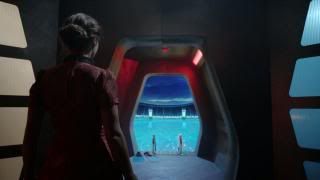
As within, so without. Within the TARDIS Clara confronts the fundamental elements of alchemy, Fire and Water. They are writ large -- a wall of fire, a swimming pool.

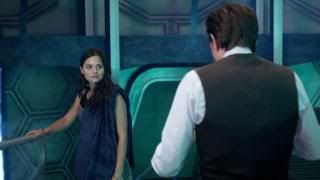
But framing the story she has the same elemental encounters -- at the beginning, she is juxtaposed with flame after the TARDIS is socked by the salvage ship, first a yellow flame and then a purple flame, the latter being explicitly alchemical. At the end, she's changed out of her red dress; now a blue towel adorns her shoulder, just as she's done washing up.


These are aspects of the TARDIS herself. Two different shots of her scanner, in the shape of an Eye, alternatively the hot interior of her Heart, and the cool exterior of the galaxy alight with stars.
These are metaphors, of course -- the ability to burn with passion, to exercise cool reason. It's being able to go between these two polarities, as if they were fused together, that gives the hero the ability to move "between the worlds" -- between the inside of intention and the outside of material action.
Having passed the Fire and the Water, Clara gets to exploring.


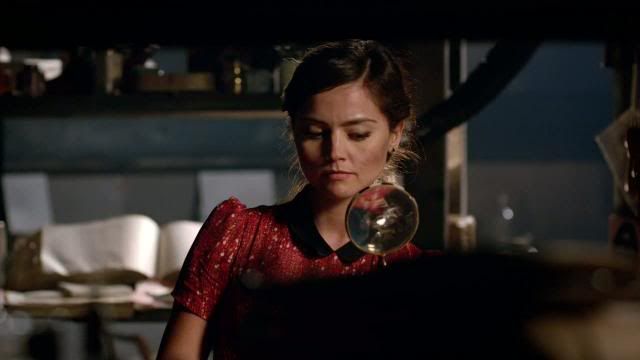

Part of understanding the nature of the Goddess is understanding the nature of her Consort, and so Clara ends up in a storage room, a room filled with the Doctor's memories. She find the Doctor's cot first, and somehow manages to brush her hand across it in the same manner River did back when we first saw it. She also finds Amy's TARDIS, and a magnifying glass -- I've got a shot around here, but on a couple occasion we see Amy looking through it. (Companions must fancy themselves Sherlock Holmes!) So, these are all artifacts from the Doctor's previous companions.
The last thing Clara finds before she's rudely interrupted is an Umbrella. Now, this is something that's not been a part of the Revival until Clara showed up. There's a whole bit in The Snowmen about the Umbrella and how Clara proves how clever she is by it. An Umbrella shows up again in Hide, which the Doctor uses to admonish Clara for dripping water all over the TARDIS.
Of all the Doctors, it was the 7th who was iconically identified with an Umbrella. He is the Doctor most notable for being manipulative, for tricking his enemies into undoing themselves, for actively seeking out situations he was already aware of in order to rectify them, usually without telling his companion in advance. Notably, it was with the 7th Doctor that the whole issue of his Name being some sort of terrible secret first entered the canon in such an explicit fashion.



The next place Clara visits is The Library.
I almost don't know where to begin. We first start getting that Forest of the Dead when the 10th Doctor visited the Library. It's where River ends up dying. It's where River reveals she knows the Doctor's Name. It's one of the most important, central metaphors of the current run.
In the TARDIS we see the Library is also an Alchemical Place. The Encyclopedia Gallifreya sits on the shelves, along with all kinds of other bottles. (Neatly, the picture on the left up there shows Vol. X -- the X motif signifying a "crossover" event, and another symbol for the principle of fusion, the conjoining of opposites.) And Clara ends up getting a whiff of the Doctor's home planet -- I wonder how much of it she'll subconsciously remember.
But we're supposed to be concerned with that Book -- the History of the Time War, the worst secrets of the Doctor. It's here Clara finds the Doctor's name. I guess that makes her a bit like River?

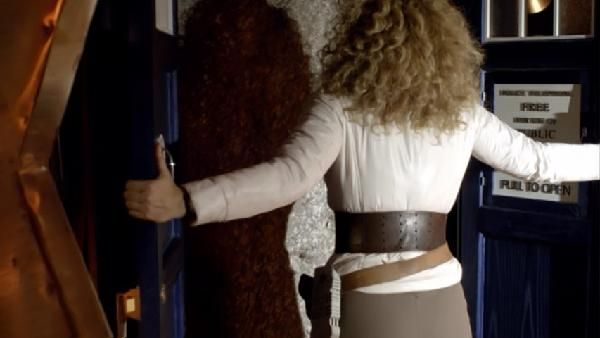
It's the perfect book for Clara to find, given the metaphorical implications of the Library.
The History of the Time War is a story of apocalypse -- Gallifrey is now a place of Death. To read a special book like this in the Library is like tapping into The Akashic Records. A "universal record" of everyone and their works; in JudeoChristian terms, The Book of Life (and The Book of Death, according to Jubilees.) It's in this sort of book that Clara finds the Doctor's name.
It's also not unlike the Magician's Book in The Voyage of the Dawn Treader, the third or fifth volume in the Chronicles of Narnia, depending on your point of view. In that story, the Book is more like the Melody Malone story -- Lucy Pevensie reads herself doing exactly what she's doing, what she's done, what she's going to do.
Lucy's also tempted by the spell that would (artificially) make her beautiful.
Now "beautiful" is one of the code-words in the current run. In particular, it's used to describe monsters -- the Minotaur in the hotel labyrinth, the Silurian on the Ark, the Siren of the Black Spot, the Star Whale... and Oswin's burnt soufflé. It's also used to describe the TARDIS, Apalapuchia, Rory's face, the word "shenanigans..."
When Clara shows the Doctor her burnt hand, she becomes "beautiful" to him.
Finally, Lucy reads a story that's immediately forgotten, the best story she ever heard. That lost story is the story Aslan will tell her for years and years. In this respect, it's a mirror of Clara reading the History of the Time War -- this story, the story of the Doctor's name, is a story the Doctor tells over and over, though Clara apparently will never remember.

Enough of the Doctor for now. When Clara returns to the Console Room, lit in Blue like the TARDIS, and now she's no longer reticent to talk to the Mother. She clasps her hands together in gratitude, kisses the console, and thanks the TARDIS out loud. But the doors to the outside are gone.
Off she goes to find The Way Out, only to find herself right back where she started from.
After a few more times around the hamster wheel, she's complaining to the TARDIS, wondering what she's done to deserve this. And then she comes face-to-face with a Monster.

Clara asks The Question: "Who are you?"
Which is to say, she's face-to-face with her future, herself, herself as a Monster. And that Monster is something she calls a Zombie. It is a future of Living Death, the most horrid "immortality" where identity has melted away leaving only molten clay.
She pounds and pounds against the doors, the doors that are not there, and then the Doctor pulls her through the looking glass, for this Console Room isn't "the original" but an echo, a mirror.

Clara comes through as a Ghost.
Remember, the Doctor only realized she was there at first because he saw her shadow pass across the console. The shadow, the shade, the part of oneself that is linked inextricably with Death.
It is at this point in the story that the Doctor realizes that the TARDIS *is* on the verge of death -- his clever ploy to fake a self-destruct sequence was a false mirror of her unprotected collision with the Salvage ship. They will have to make a Journey to the Centre, or the TARDIS will be lost.
L O S T

If there's a running theme to this season, it's the nature of being Lost. It all begins in The Bells of Saint John, where people who are Spooned up in the "Cloud" can only go on and on about how they don't know where they are. This is the first, most basic sense of being lost, but the juxtaposition of the Cloud -- and how it renders people so lifeless they may as well be dead, whether it's at a café or on the verge of a plane crash -- suggests that lost is a metaphor for death.
Consider Rings of Akhaten, when Clara tells a story to Merry about how she got lost. It was at Blackpool Beach -- a "black pool" is nature's mirror, or like a deep, dark well -- and Clara paints it apocalyptic terms: it was like the world ended, her heart broken. Until she's found, by her Mother. Does Clara lose the certainty of her mother always finding her now that she's given up that Leaf?
Cold War has Skaldak who got lost in a block of ice, but it's Clara who sings a key phrase from Hungry Like The Wolf to empathize: "I'm lost and I'm found." In Hide Clara doesn't get lost, but the phrase "lost soul" is repeated several times to describe the time-traveling Great-Granddaughter who ends up in the Forest on the Other Side.
In all these cases, the place where one gets lost is "special," whether it's the Cloud or the Forest or deep under water. Journey to the Center of the TARDIS begins with Clara getting lost in the TARDIS, which makes the TARDIS the "special place" of this episode. With that in mind, it's more clear that Journey to the Centre also functions as an extended metaphor for death, and the TARDIS becomes that lost place.
"She is also the death of everything that dies... the womb and the tomb."
-- Joseph Campbell, "Meeting With The Goddess"
Funny thing is, Clara gets lost twice in this episode. First she gets lost after the TARDIS crashes. She's found in the Console Room, but almost as soon as the party heads to the Centre Clara gets lost again. She starts seeing ghosts of her past, mirror images, echoes. Which makes sense -- if being lost is like being dead, and Clara's the Woman Twice Dead, then she should get lost twice.
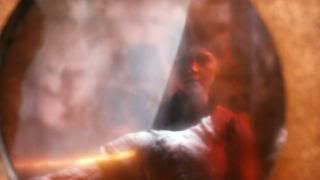
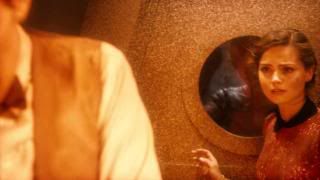
Having seen ghosts of herself, echoes of the past, Clara's now ready to see a vision of her future. At this point, the telling of the tale is a miniature recapitulation of Dante's Divine Comedy.
The Eye of Harmony is their "Inferno;" the Time Zombies aren't truly dead, but wander about nearly immortal in their torment. Here Clara sees her self through a glass darkly, juxtaposed with her own reflection -- there's a monster on the other side of the window, and the identification scanner determines it's full of Lancashire cells and "sass" -- this is Clara.
This is hell.


It's also worth noting that we've seen the TARDIS as a Sun Goddess before, a great big burning Eye.
This is fairly unusual but not unheard of in ancient mythology. One myth in particular is worth bearing in mind. The Shinto goddess Amaterasu went into hiding because her brother, the Storm god Susanowo, was acting like a complete jerk, going so far as to scare the goddess's ladies to death.
Amaterasu hides in a heavenly cave, shutting the door so as to blot out any light from shining upon the Universe, threatening apocalypse. The other deities form a plan: they adorn a Great Tree outside the cave with jewels, and hang an enormous mirror from its boughs. They sang and danced and laughed so loud the goddess had to see, for she had assumed that she had left only misery in her wake. She demands to know what the merriment is all about, and they answer that they are rejoicing in a deity more illustrious than the sun-goddess herself. They point at the mirror, and while she gazes upon her reflection in astonishment, they bar the entrance to the cave such that she can never disappear completely again.
It's also possible that Red Ridinghood, who was originally Red Riding Cap, was a metaphor for the Sun, swallowed by the Big Bad Wolf, only to be resurrected through its belly thanks to the intervention of a Woodsman.

The next stop is Purgatorio. It's where Clara and the Doctor have to be honest with each other, where confessions are made. The Doctor demands to know "who you are," and when she mirrors that with the declaration he already knows who she is, he can only purge his frustration and burning curiosity, his knowledge of that who she "is" is someone who's died twice.
In return, Clara admits her fear of him.
And that's saying something, considering all the terrible things she's seen, especially in the TARDIS. So it's not that she fears Death more than anything (and why would she, having died so many times!) but the power of the Trickster, the mad man, chaos personified.
Once the purging's done, there's no more punching to be had. Now they hug and get ready for that final jump, the Leap of Faith that will bring them to the Other Side, into the Heart.
DOCTOR: The TARDIS is snarling at us, trying to frighten us off. We need to jump.
CLARA: You're insane.
DOCTOR: We'll cross a portal to the engine.
CLARA: How can you be so sure?
DOCTOR: Well, I can't.
CLARA: OK, well, that's watertight.
Notice how there's a River below.

The Heart: Paradiso.
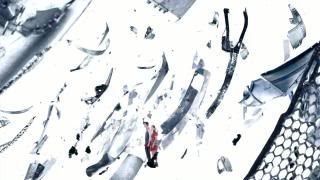
It's paradise for their relationship. They hold hands, appreciate each other, seeing the beauty of fire (Clara's hand) and ice (the Engine.) It's where they hear the Music.
The Heart of the TARDIS is literally frozen in time as it dies -- "winter is coming," Skaldak in a block of ice, the cold spot in the Music Room of Caliburn House, Clara stuck to the Mummy's Glass. People coming to a full stop under the influence of the WiFi -- "are they dead?" Clara asks of the people on the Plane. The Cloud at Christmas is made of ice-crystals; the surface of the Asylum is covered in Snow.
The Heart of the TARDIS is all white, again with the heavenly imagery. The Doctor and Clara both die in this vehicle, only to be reborn in the end; the whole story is a near-death experience.
But wait, it gets better! The Doctor realizes that they've done this before, that he threw the Button through the breach earlier, and has to get it right this time. Which means that they've died twice in this story.
Once again, Clara dies twice. This time, the Doctor joins her.

The Heart is a place of Alchemy:
CLARA: We're not dead.
DOCTOR: She wrapped her hands around the force. Froze it.
CLARA: So... so it's safe?
DOCTOR: Temporary fix. Eventually, this whole place will erupt.
Yet another juxtaposition of fire and ice -- and lo and behold, it's a song that leads them out of this place. Put them together and you get "A Song of Ice and Fire" -- Game of Thrones. Hmm. The Chair Agenda?
That song, by the way, is "Fire Woman" by The Cult.
Clara Who?

So once again I'm going to speculate on the nature of Clara.
One of the final shots has the Doctor wiping down the time rotor of the TARDIS, when Clara comes in toweling herself off after a bath. Both, in essence, have been "cleaned" and to make the juxtaposition even more explicity the Doctor swishes his cloth over Clara's head.
Is Clara a TARDIS? Or is she going to become a TARDIS?


Eggs.
At the beginning of Series Seven -- really, since The Wardrobe -- we'eve been served all kinds of eggs. "Easter Eggs," perhaps, little clues pointing us in the direction of what's to come.
It started in the Androzani Forest. The Trees had their own ornaments, silvery mirror-like orbs that were actually eggs. A "god" emerged from one of those eggs, and led our heroes to a Tower which turned out to be a place of Ascension, where Madge sat in a mighty Chair and took thousand of stars -- the spirit of the Forest -- into her head, before taking off into the vortex.
Then in Aslyum, we got the actual word repeated over and over again, but this time with a darker tone. "Eggs" is the beginning of Exterminate -- Eggs being likened to X, that principle of juxtaposition. While the Asylum is a "cracked" planet (funny enough, the Doctor worries that the Library planet will "crack like an egg" if The Little Girl isn't dealt with) and eventually explodes when the sperm-like Dalek missles find it, I'm more reminded of Big Bang Two, when the fiery exploding TARDIS is fertilized by the Pandorica, the Monster-Box, conferring Rebirth to the Universe. River is conceived that night, and she is at the heart of the explosion.
Dinosaurs on a Spaceship has a white glowing spherical object that contains the history of the Ark. A Town Called Mercy features a spaceship shaped like an egg, which is a vehicle of self-sacrifice. And in all three of these stories, there's juxtaposition with Flashing Lights.
In Journey the Eggs on the World Tree are Flashing Lights.
But here we get something new with Eggs. The Eggs are identified as "bespoke engineering." That's an interesting word, "bespoke." It's been used once before in the Revival -- in Let's Kill Hitler, where the Doctor describes River as his "bespoke psychopath." As if she were tailor-made for him.
Now it turns out that the resolution to this story also involves an Egg -- which the Doctor engineers with magic words into his own bit of "bespoke engineering" -- a Big Friendly Button. Something to reboot or reset the events that have just transpired. Not unlike Big Bang Two. Both the TARDIS egg and the Silver Egg, just for a little extra dash of juxtaposition, end up rolling on the floor at one point. Both have the effect of making the TARDIS furious.
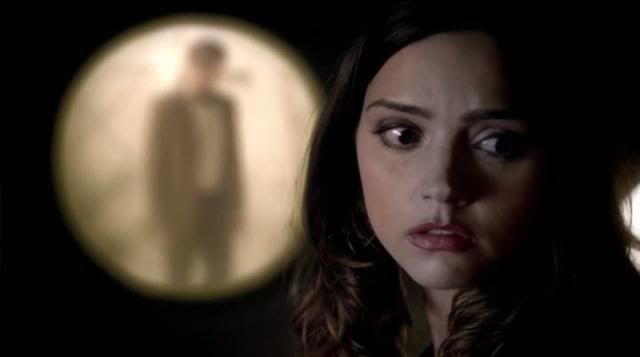

Clara, who as Oswin repeated the Egg word as the Soufflé Girl of the Asylum, picks up the Silver Egg (silver is the color of a mirror) and has the words burned on her Hand.
Bespoke engineering. Eggs.
But these words are reversed. Is Clara the reverse of a Big Friendly Button? Back in Rings of Akhaten I noticed she was juxtaposed with the Mummy, behind that box of glass, against which she's frozen stiff for several minutes. That juxtaposition suggested she was some kind of Alarm Clock.
The monster in the glass box was called a "vampire" by the Doctor.

Which brings me to this image. This is what we see underneath the space that's underneath the Console -- this is the sub-basement of the Underworld.
First we have a Ladder, which has been a big part of Clara's mythology so far -- she has those ascensions up a Ladder to the TARDIS in The Snowmen, and she has her own Ladder descending to the heart of the Asylum. The Ladder permits transit between the worlds.
It's juxtaposed with a Light Cord. The Light Cord was how the Doctor, Amy, and Rory got to the Asylum surface. It's the same imagery used to put Clara back in her body after the Doctor interrupts the Spoonhead, and it's the same imagery that raises the Submarine in Cold War. Way back in The Long Game, it connects the Third Eye of someone sitting in a special chair to Satellite Five, giving them access to a Universal Record writ small.
So we have two images strongly associated with Ascension underneath the Console, and look who's coming on down: it's not Clara. It's one of the Van Baalen brothers.
His name is Bram.
That's a name most strongly associated with Bram Stoker, who wrote the iconic vampire story, Dracula. Another, different tale of the Undead. Bram is murdered by the Clara-Monster. She burns him, like a Fire Woman, straddling his body in an almost suggestive pose:

Hard to see with all that blurring.
Now it should be noted that this is partly the Doctor's doing -- this future of echo of Clara is only the way she is because the Doctor brought her to the Eye of Harmony, a subset of which we saw last week in the Music Room of Caliburn House, juxtaposed with Clara's forehead.
Is Clara really a Fire Woman?
Take the fireball scene again, shortly after Clara first got lost in the TARDIS. She walks up to a door, sees a flashing red light, and wonders whether she should press the button. A narrative convention gives us access to her thoughts -- she's speaking them aloud, not a voice-over nor as a thought-bubble, but actual proper dialogue. This is a bit unreal, but it's a common enough convention in Doctor Who.
She pushes the button, sees the fire, but before she runs away she makes a comment: "Bad Decision." What her "bad decision" line does, in the end, is show (not tell) how she is self-aware and self-critical; she's not purely reactive, but thoughtful and deliberate in her intentions. She answers the question she posed at the beginning of the scene, regarding the context of the flashing red light and whether it means she should go forward and open the door, or not. The importance of self-knowing to her is shown by that particular directorial choice.
This also demonstrates a self-consciousness of the text, the genre-savvy character. I mean, she does go on about the "rules of storytelling" regarding the Doctor keeping Zombies in the ship, she makes the Ghostbusters joke in Hide, she uses storytelling to bond with Merry (which we also saw with the Latimer kids) -- faced with the gigantic "wall of fire" trope she responds with another trope of making a quip and running away. At least she didn't jump and dive at the end, a trope the Doctor uses all the time.
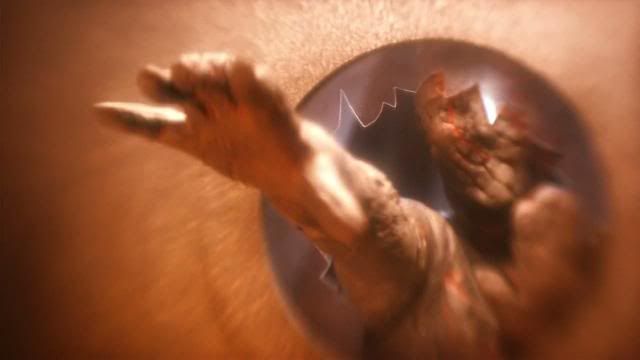
Speaking of tropes, a Zombie hand breaking through a barrier certainly qualifies! But it's usually coming up from the ground, not through a looking glass. The latter is more apt for Doctor Who, however.
Anyways, I wonder if these somewhat obvious tropes are an indication of what's going on with the Doctor in his quest to understand Clara, and the reports of some viewers who are struggling to connect with the new Companion. These kinds of tropes, when applied to Clara, make her a bit "unreal" herself -- and there's been plenty of commentary from the stories themselves regarding what is and is not actually, properly "real" -- but it's ultimately a reflection of an inversion of the most basic trope established from Rose.
In Rose, we quickly get to know the Companion first. She is the audience identification figure, and it's through her eyes that we get to know the Doctor. Here, that dynamic has been reversed. Now it's the Doctor who's the known variable, and the Companion who's the mystery. It goes completely against expectations.
By setting up Clara herself as The Reveal, she is kept at a distance from us, even though we've been given a lot: her relationship to kids, her parents, the TARDIS, her fear, her cleverness, her sense of humor, her curiosity, her self-confidence. She's willing to stand up to the Doctor, and won't back down -- Amy, for example, would shrug off his evasions with a half-heart chuckle. Not Clara.
But this is right on the point of The Question: how do we come to know who someone is? "Who are you?" is the question asked over and over again; rare is the episode where it's not asked. How does one even go about answering it?
Who are you?
Clara Who?
Perhaps there's one final clue to unearth in this episode. It's that last scene. Clara's remembered where the swimming pool is, apparently, and given the events back on the Salvage Ship -- the other brother now has a "scrap of decency" -- it's implied that the Reset has subtley altered the fabric of reality. The experiences of this journey were not lost so much as buried -- in the subconscious mind, which is where all memories go, eventually.
The very last line suggests that Clara remembers more, perhaps, than is immediately apparent, at some level. But it also suggests, I maintain, something of Clara's nature -- who she is.
DOCTOR: Anything could happen to you.
CLARA: That's what I'm counting on. Push the button.
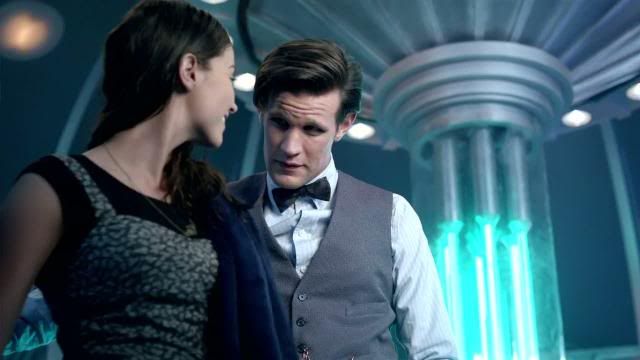
Thanks for reading!
Journey to the Centre of the TARDIS
spoilers through the episode
Hello, sweetie...
Meeting with the Goddess

Goodness gracious me, just look at that lovely tree!
I've been writing about The World Tree for some time now. This is getting ridiculous, isn't it? A tree that represents "everything" -- all that ever could be, stored in the very genetic architecture of the TARDIS.
Well, according to Gregor's scanner, the identification device. Funny thing is, when he prepared to open that door, behind which "everything" resided, I expected something completely different than an Egg Tree, and yet the Egg Tree is perfect for what I had in mind. Because on the Series Five DVD set is a bonus scene that fits between The Eleventh Hour and The Beast Below, Amy's first experience in the TARDIS. And at the end of the scene, this came up:
DOCTOR: You know what I keep in here?
AMY: What?
DOCTOR: Absolutely everything. Anything take your fancy?

That's right, the whole Universe. Amy can't believe it's "real".
Anyways, it isn't enough that the TARDIS can find any place in time that ever was, now we see she is truly the Mother, laden with hundreds of Eggs, like a Christmas full of enormous Light Bulbs.
The World Tree connects that which is above with that which is below. As goes the Tree, so goes the Universe. So it's telling that when one of the Eggs is "salvaged" the whole tree blinks, as if suddenly she died, only to light up again once more.
Birth, Death, Rebirth, all in one image. This is a reflection of the cycle of the material plane of existence. The "totality of the Universe, the harmonization of all the pairs of opposites, combining wonderfully the terror of absolute destruction with an impersonal yet motherly reassurance," as Joseph Campbell puts it.

The Heroic Journey continues apace for Clara, but it's all twisty and bent. The Bells of Saint John marked the "Call to Adventure" in no uncertain terms, but it's Clara making the call. The Rings of Akhaten presents her Supernatural Aid, but she has to give up the Leaf. Cold War is her journey into the Belly of the Whale, and Hide is her "road of trials," where she has to prove her mettle without help from the Doctor.
The Meeting With the Goddess is all about confronting the majesty of the Divine Feminine in all her terrible beauty. For the Heroine, it's a glimpse into her own nature, as a physically manifest being. To be material is to be ephemeral, subject to Time. Time is the principle of Change, and so Clara will see her past and her future through the labyrinth of the TARDIS.
What a wonderful place to get lost! But Clara's reluctant to meet the Mother Goddess at first:
CLARA: You're not getting me to talk to your ship. That's properly bonkers.
DOCTOR: It's OK, it's OK.
CLARA: You're like one of those guys who can't go out with a girl unless his mother approves.
The Doctor suggests maybe leaving the two alone at first, and lo and behold that actually manifests. The Doctor ends up outside, while Clara's left inside, free to explore the nature of the Universe itself on her own terms.
Alchemical terms.


As within, so without. Within the TARDIS Clara confronts the fundamental elements of alchemy, Fire and Water. They are writ large -- a wall of fire, a swimming pool.


But framing the story she has the same elemental encounters -- at the beginning, she is juxtaposed with flame after the TARDIS is socked by the salvage ship, first a yellow flame and then a purple flame, the latter being explicitly alchemical. At the end, she's changed out of her red dress; now a blue towel adorns her shoulder, just as she's done washing up.


These are aspects of the TARDIS herself. Two different shots of her scanner, in the shape of an Eye, alternatively the hot interior of her Heart, and the cool exterior of the galaxy alight with stars.
These are metaphors, of course -- the ability to burn with passion, to exercise cool reason. It's being able to go between these two polarities, as if they were fused together, that gives the hero the ability to move "between the worlds" -- between the inside of intention and the outside of material action.
Having passed the Fire and the Water, Clara gets to exploring.




Part of understanding the nature of the Goddess is understanding the nature of her Consort, and so Clara ends up in a storage room, a room filled with the Doctor's memories. She find the Doctor's cot first, and somehow manages to brush her hand across it in the same manner River did back when we first saw it. She also finds Amy's TARDIS, and a magnifying glass -- I've got a shot around here, but on a couple occasion we see Amy looking through it. (Companions must fancy themselves Sherlock Holmes!) So, these are all artifacts from the Doctor's previous companions.
The last thing Clara finds before she's rudely interrupted is an Umbrella. Now, this is something that's not been a part of the Revival until Clara showed up. There's a whole bit in The Snowmen about the Umbrella and how Clara proves how clever she is by it. An Umbrella shows up again in Hide, which the Doctor uses to admonish Clara for dripping water all over the TARDIS.
Of all the Doctors, it was the 7th who was iconically identified with an Umbrella. He is the Doctor most notable for being manipulative, for tricking his enemies into undoing themselves, for actively seeking out situations he was already aware of in order to rectify them, usually without telling his companion in advance. Notably, it was with the 7th Doctor that the whole issue of his Name being some sort of terrible secret first entered the canon in such an explicit fashion.



The next place Clara visits is The Library.
I almost don't know where to begin. We first start getting that Forest of the Dead when the 10th Doctor visited the Library. It's where River ends up dying. It's where River reveals she knows the Doctor's Name. It's one of the most important, central metaphors of the current run.
In the TARDIS we see the Library is also an Alchemical Place. The Encyclopedia Gallifreya sits on the shelves, along with all kinds of other bottles. (Neatly, the picture on the left up there shows Vol. X -- the X motif signifying a "crossover" event, and another symbol for the principle of fusion, the conjoining of opposites.) And Clara ends up getting a whiff of the Doctor's home planet -- I wonder how much of it she'll subconsciously remember.
But we're supposed to be concerned with that Book -- the History of the Time War, the worst secrets of the Doctor. It's here Clara finds the Doctor's name. I guess that makes her a bit like River?


It's the perfect book for Clara to find, given the metaphorical implications of the Library.
The History of the Time War is a story of apocalypse -- Gallifrey is now a place of Death. To read a special book like this in the Library is like tapping into The Akashic Records. A "universal record" of everyone and their works; in JudeoChristian terms, The Book of Life (and The Book of Death, according to Jubilees.) It's in this sort of book that Clara finds the Doctor's name.
It's also not unlike the Magician's Book in The Voyage of the Dawn Treader, the third or fifth volume in the Chronicles of Narnia, depending on your point of view. In that story, the Book is more like the Melody Malone story -- Lucy Pevensie reads herself doing exactly what she's doing, what she's done, what she's going to do.
Lucy's also tempted by the spell that would (artificially) make her beautiful.
Now "beautiful" is one of the code-words in the current run. In particular, it's used to describe monsters -- the Minotaur in the hotel labyrinth, the Silurian on the Ark, the Siren of the Black Spot, the Star Whale... and Oswin's burnt soufflé. It's also used to describe the TARDIS, Apalapuchia, Rory's face, the word "shenanigans..."
When Clara shows the Doctor her burnt hand, she becomes "beautiful" to him.
Finally, Lucy reads a story that's immediately forgotten, the best story she ever heard. That lost story is the story Aslan will tell her for years and years. In this respect, it's a mirror of Clara reading the History of the Time War -- this story, the story of the Doctor's name, is a story the Doctor tells over and over, though Clara apparently will never remember.

Enough of the Doctor for now. When Clara returns to the Console Room, lit in Blue like the TARDIS, and now she's no longer reticent to talk to the Mother. She clasps her hands together in gratitude, kisses the console, and thanks the TARDIS out loud. But the doors to the outside are gone.
Off she goes to find The Way Out, only to find herself right back where she started from.
After a few more times around the hamster wheel, she's complaining to the TARDIS, wondering what she's done to deserve this. And then she comes face-to-face with a Monster.

Clara asks The Question: "Who are you?"
Which is to say, she's face-to-face with her future, herself, herself as a Monster. And that Monster is something she calls a Zombie. It is a future of Living Death, the most horrid "immortality" where identity has melted away leaving only molten clay.
She pounds and pounds against the doors, the doors that are not there, and then the Doctor pulls her through the looking glass, for this Console Room isn't "the original" but an echo, a mirror.

Clara comes through as a Ghost.
Remember, the Doctor only realized she was there at first because he saw her shadow pass across the console. The shadow, the shade, the part of oneself that is linked inextricably with Death.
It is at this point in the story that the Doctor realizes that the TARDIS *is* on the verge of death -- his clever ploy to fake a self-destruct sequence was a false mirror of her unprotected collision with the Salvage ship. They will have to make a Journey to the Centre, or the TARDIS will be lost.
L O S T

If there's a running theme to this season, it's the nature of being Lost. It all begins in The Bells of Saint John, where people who are Spooned up in the "Cloud" can only go on and on about how they don't know where they are. This is the first, most basic sense of being lost, but the juxtaposition of the Cloud -- and how it renders people so lifeless they may as well be dead, whether it's at a café or on the verge of a plane crash -- suggests that lost is a metaphor for death.
Consider Rings of Akhaten, when Clara tells a story to Merry about how she got lost. It was at Blackpool Beach -- a "black pool" is nature's mirror, or like a deep, dark well -- and Clara paints it apocalyptic terms: it was like the world ended, her heart broken. Until she's found, by her Mother. Does Clara lose the certainty of her mother always finding her now that she's given up that Leaf?
Cold War has Skaldak who got lost in a block of ice, but it's Clara who sings a key phrase from Hungry Like The Wolf to empathize: "I'm lost and I'm found." In Hide Clara doesn't get lost, but the phrase "lost soul" is repeated several times to describe the time-traveling Great-Granddaughter who ends up in the Forest on the Other Side.
In all these cases, the place where one gets lost is "special," whether it's the Cloud or the Forest or deep under water. Journey to the Center of the TARDIS begins with Clara getting lost in the TARDIS, which makes the TARDIS the "special place" of this episode. With that in mind, it's more clear that Journey to the Centre also functions as an extended metaphor for death, and the TARDIS becomes that lost place.
"She is also the death of everything that dies... the womb and the tomb."
-- Joseph Campbell, "Meeting With The Goddess"
Funny thing is, Clara gets lost twice in this episode. First she gets lost after the TARDIS crashes. She's found in the Console Room, but almost as soon as the party heads to the Centre Clara gets lost again. She starts seeing ghosts of her past, mirror images, echoes. Which makes sense -- if being lost is like being dead, and Clara's the Woman Twice Dead, then she should get lost twice.


Having seen ghosts of herself, echoes of the past, Clara's now ready to see a vision of her future. At this point, the telling of the tale is a miniature recapitulation of Dante's Divine Comedy.
The Eye of Harmony is their "Inferno;" the Time Zombies aren't truly dead, but wander about nearly immortal in their torment. Here Clara sees her self through a glass darkly, juxtaposed with her own reflection -- there's a monster on the other side of the window, and the identification scanner determines it's full of Lancashire cells and "sass" -- this is Clara.
This is hell.


It's also worth noting that we've seen the TARDIS as a Sun Goddess before, a great big burning Eye.
This is fairly unusual but not unheard of in ancient mythology. One myth in particular is worth bearing in mind. The Shinto goddess Amaterasu went into hiding because her brother, the Storm god Susanowo, was acting like a complete jerk, going so far as to scare the goddess's ladies to death.
Amaterasu hides in a heavenly cave, shutting the door so as to blot out any light from shining upon the Universe, threatening apocalypse. The other deities form a plan: they adorn a Great Tree outside the cave with jewels, and hang an enormous mirror from its boughs. They sang and danced and laughed so loud the goddess had to see, for she had assumed that she had left only misery in her wake. She demands to know what the merriment is all about, and they answer that they are rejoicing in a deity more illustrious than the sun-goddess herself. They point at the mirror, and while she gazes upon her reflection in astonishment, they bar the entrance to the cave such that she can never disappear completely again.
It's also possible that Red Ridinghood, who was originally Red Riding Cap, was a metaphor for the Sun, swallowed by the Big Bad Wolf, only to be resurrected through its belly thanks to the intervention of a Woodsman.

The next stop is Purgatorio. It's where Clara and the Doctor have to be honest with each other, where confessions are made. The Doctor demands to know "who you are," and when she mirrors that with the declaration he already knows who she is, he can only purge his frustration and burning curiosity, his knowledge of that who she "is" is someone who's died twice.
In return, Clara admits her fear of him.
And that's saying something, considering all the terrible things she's seen, especially in the TARDIS. So it's not that she fears Death more than anything (and why would she, having died so many times!) but the power of the Trickster, the mad man, chaos personified.
Once the purging's done, there's no more punching to be had. Now they hug and get ready for that final jump, the Leap of Faith that will bring them to the Other Side, into the Heart.
DOCTOR: The TARDIS is snarling at us, trying to frighten us off. We need to jump.
CLARA: You're insane.
DOCTOR: We'll cross a portal to the engine.
CLARA: How can you be so sure?
DOCTOR: Well, I can't.
CLARA: OK, well, that's watertight.
Notice how there's a River below.

The Heart: Paradiso.

It's paradise for their relationship. They hold hands, appreciate each other, seeing the beauty of fire (Clara's hand) and ice (the Engine.) It's where they hear the Music.
The Heart of the TARDIS is literally frozen in time as it dies -- "winter is coming," Skaldak in a block of ice, the cold spot in the Music Room of Caliburn House, Clara stuck to the Mummy's Glass. People coming to a full stop under the influence of the WiFi -- "are they dead?" Clara asks of the people on the Plane. The Cloud at Christmas is made of ice-crystals; the surface of the Asylum is covered in Snow.
The Heart of the TARDIS is all white, again with the heavenly imagery. The Doctor and Clara both die in this vehicle, only to be reborn in the end; the whole story is a near-death experience.
But wait, it gets better! The Doctor realizes that they've done this before, that he threw the Button through the breach earlier, and has to get it right this time. Which means that they've died twice in this story.
Once again, Clara dies twice. This time, the Doctor joins her.

The Heart is a place of Alchemy:
CLARA: We're not dead.
DOCTOR: She wrapped her hands around the force. Froze it.
CLARA: So... so it's safe?
DOCTOR: Temporary fix. Eventually, this whole place will erupt.
Yet another juxtaposition of fire and ice -- and lo and behold, it's a song that leads them out of this place. Put them together and you get "A Song of Ice and Fire" -- Game of Thrones. Hmm. The Chair Agenda?
That song, by the way, is "Fire Woman" by The Cult.
Clara Who?

So once again I'm going to speculate on the nature of Clara.
One of the final shots has the Doctor wiping down the time rotor of the TARDIS, when Clara comes in toweling herself off after a bath. Both, in essence, have been "cleaned" and to make the juxtaposition even more explicity the Doctor swishes his cloth over Clara's head.
Is Clara a TARDIS? Or is she going to become a TARDIS?


Eggs.
At the beginning of Series Seven -- really, since The Wardrobe -- we'eve been served all kinds of eggs. "Easter Eggs," perhaps, little clues pointing us in the direction of what's to come.
It started in the Androzani Forest. The Trees had their own ornaments, silvery mirror-like orbs that were actually eggs. A "god" emerged from one of those eggs, and led our heroes to a Tower which turned out to be a place of Ascension, where Madge sat in a mighty Chair and took thousand of stars -- the spirit of the Forest -- into her head, before taking off into the vortex.
Then in Aslyum, we got the actual word repeated over and over again, but this time with a darker tone. "Eggs" is the beginning of Exterminate -- Eggs being likened to X, that principle of juxtaposition. While the Asylum is a "cracked" planet (funny enough, the Doctor worries that the Library planet will "crack like an egg" if The Little Girl isn't dealt with) and eventually explodes when the sperm-like Dalek missles find it, I'm more reminded of Big Bang Two, when the fiery exploding TARDIS is fertilized by the Pandorica, the Monster-Box, conferring Rebirth to the Universe. River is conceived that night, and she is at the heart of the explosion.
Dinosaurs on a Spaceship has a white glowing spherical object that contains the history of the Ark. A Town Called Mercy features a spaceship shaped like an egg, which is a vehicle of self-sacrifice. And in all three of these stories, there's juxtaposition with Flashing Lights.
In Journey the Eggs on the World Tree are Flashing Lights.
But here we get something new with Eggs. The Eggs are identified as "bespoke engineering." That's an interesting word, "bespoke." It's been used once before in the Revival -- in Let's Kill Hitler, where the Doctor describes River as his "bespoke psychopath." As if she were tailor-made for him.
Now it turns out that the resolution to this story also involves an Egg -- which the Doctor engineers with magic words into his own bit of "bespoke engineering" -- a Big Friendly Button. Something to reboot or reset the events that have just transpired. Not unlike Big Bang Two. Both the TARDIS egg and the Silver Egg, just for a little extra dash of juxtaposition, end up rolling on the floor at one point. Both have the effect of making the TARDIS furious.


Clara, who as Oswin repeated the Egg word as the Soufflé Girl of the Asylum, picks up the Silver Egg (silver is the color of a mirror) and has the words burned on her Hand.
Bespoke engineering. Eggs.
But these words are reversed. Is Clara the reverse of a Big Friendly Button? Back in Rings of Akhaten I noticed she was juxtaposed with the Mummy, behind that box of glass, against which she's frozen stiff for several minutes. That juxtaposition suggested she was some kind of Alarm Clock.
The monster in the glass box was called a "vampire" by the Doctor.

Which brings me to this image. This is what we see underneath the space that's underneath the Console -- this is the sub-basement of the Underworld.
First we have a Ladder, which has been a big part of Clara's mythology so far -- she has those ascensions up a Ladder to the TARDIS in The Snowmen, and she has her own Ladder descending to the heart of the Asylum. The Ladder permits transit between the worlds.
It's juxtaposed with a Light Cord. The Light Cord was how the Doctor, Amy, and Rory got to the Asylum surface. It's the same imagery used to put Clara back in her body after the Doctor interrupts the Spoonhead, and it's the same imagery that raises the Submarine in Cold War. Way back in The Long Game, it connects the Third Eye of someone sitting in a special chair to Satellite Five, giving them access to a Universal Record writ small.
So we have two images strongly associated with Ascension underneath the Console, and look who's coming on down: it's not Clara. It's one of the Van Baalen brothers.
His name is Bram.
That's a name most strongly associated with Bram Stoker, who wrote the iconic vampire story, Dracula. Another, different tale of the Undead. Bram is murdered by the Clara-Monster. She burns him, like a Fire Woman, straddling his body in an almost suggestive pose:

Hard to see with all that blurring.
Now it should be noted that this is partly the Doctor's doing -- this future of echo of Clara is only the way she is because the Doctor brought her to the Eye of Harmony, a subset of which we saw last week in the Music Room of Caliburn House, juxtaposed with Clara's forehead.
Is Clara really a Fire Woman?
Take the fireball scene again, shortly after Clara first got lost in the TARDIS. She walks up to a door, sees a flashing red light, and wonders whether she should press the button. A narrative convention gives us access to her thoughts -- she's speaking them aloud, not a voice-over nor as a thought-bubble, but actual proper dialogue. This is a bit unreal, but it's a common enough convention in Doctor Who.
She pushes the button, sees the fire, but before she runs away she makes a comment: "Bad Decision." What her "bad decision" line does, in the end, is show (not tell) how she is self-aware and self-critical; she's not purely reactive, but thoughtful and deliberate in her intentions. She answers the question she posed at the beginning of the scene, regarding the context of the flashing red light and whether it means she should go forward and open the door, or not. The importance of self-knowing to her is shown by that particular directorial choice.
This also demonstrates a self-consciousness of the text, the genre-savvy character. I mean, she does go on about the "rules of storytelling" regarding the Doctor keeping Zombies in the ship, she makes the Ghostbusters joke in Hide, she uses storytelling to bond with Merry (which we also saw with the Latimer kids) -- faced with the gigantic "wall of fire" trope she responds with another trope of making a quip and running away. At least she didn't jump and dive at the end, a trope the Doctor uses all the time.


Speaking of tropes, a Zombie hand breaking through a barrier certainly qualifies! But it's usually coming up from the ground, not through a looking glass. The latter is more apt for Doctor Who, however.
Anyways, I wonder if these somewhat obvious tropes are an indication of what's going on with the Doctor in his quest to understand Clara, and the reports of some viewers who are struggling to connect with the new Companion. These kinds of tropes, when applied to Clara, make her a bit "unreal" herself -- and there's been plenty of commentary from the stories themselves regarding what is and is not actually, properly "real" -- but it's ultimately a reflection of an inversion of the most basic trope established from Rose.
In Rose, we quickly get to know the Companion first. She is the audience identification figure, and it's through her eyes that we get to know the Doctor. Here, that dynamic has been reversed. Now it's the Doctor who's the known variable, and the Companion who's the mystery. It goes completely against expectations.
By setting up Clara herself as The Reveal, she is kept at a distance from us, even though we've been given a lot: her relationship to kids, her parents, the TARDIS, her fear, her cleverness, her sense of humor, her curiosity, her self-confidence. She's willing to stand up to the Doctor, and won't back down -- Amy, for example, would shrug off his evasions with a half-heart chuckle. Not Clara.
But this is right on the point of The Question: how do we come to know who someone is? "Who are you?" is the question asked over and over again; rare is the episode where it's not asked. How does one even go about answering it?
Who are you?
Clara Who?
Perhaps there's one final clue to unearth in this episode. It's that last scene. Clara's remembered where the swimming pool is, apparently, and given the events back on the Salvage Ship -- the other brother now has a "scrap of decency" -- it's implied that the Reset has subtley altered the fabric of reality. The experiences of this journey were not lost so much as buried -- in the subconscious mind, which is where all memories go, eventually.
The very last line suggests that Clara remembers more, perhaps, than is immediately apparent, at some level. But it also suggests, I maintain, something of Clara's nature -- who she is.
DOCTOR: Anything could happen to you.
CLARA: That's what I'm counting on. Push the button.

Thanks for reading!